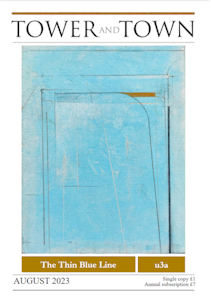

Tower and Town, August 2023 (view the full edition) (view the full edition)Policing In Marlborough 1969 - 1987
The hub of the building was the public enquiry office, to which the public had access. This was visited by a variety of people and was usually manned by an experienced officer because all sorts of questions would be asked, quite often not a police matter. The patrolling officers mostly dealt with traffic accidents and offences, petty crime, public order and domestic disputes, which were the most difficult to deal with. As with all County Forces, at that time, all officers from the Chief Constable down doubled as Inspectors of Animals under the Diseases of Animals Act, so inspecting farmers' livestock movement registers was another duty. Marlborough Sub Division consisted of the town and surrounding villages, commanded by a Chief Inspector or Inspector and 2 Sections (a Sergeant and six Constables, both male and female) at first, but when I was promoted it was 3 Sections. This seems to be a lot of Officers to cover this area with a low population but when you take into consideration Rest Days, Leave and Training Courses etc. it was rare for a full section to be on duty together. As well as the regular officers, there was a small number of Special Constables, local volunteers with training, who had the same powers as the regulars when they were on duty. They were a useful back up especially on busy evenings and when large crowds were involved. The annual Mop Fairs in October were two events when extra help was needed so as well as the Specials further help was provided from Swindon. For several years Marlborough Carnival was held in June, when a procession started at the Common, through Kingsbury Street and both sides of the High Street. This was an easier crowd to deal with as everyone was in a jovial mood so the main problem was ensuring safety to all those involved. The present day Police officers seem to be weighed down with the equipment they carry but in my time we were issued with a whistle, handcuffs and a truncheon. The whistle was by now virtually redundant but was still worn in a pocket of the tunic with the chain showing. The handcuffs were difficult to use. The truncheon was carried in a pocket in the uniform trouser leg. On a personal note, in 30 years service, I never once used the truncheon, but it did save me from injury on one occasion. When making an enquiry at a house in Marlborough, the lady occupant opened her door and her large dog, who had just had puppies, rushed out and went for my thigh but all she got was a mouthful of trouser and beech wood! Communications were also very basic at this time. All the vehicles and the Office had radios which were controlled through Headquarters at Devizes. Mobile phones were in their infancy and at first we were issued with large hand-held implements and later a slimmer version. Both would only work with an extended aerial and weren't very reliable. The forerunner of the computer, the teleprinter, was installed in the office. This was a great help with enquiries to or from other forces as the sender could type out details, while a telephone call could miss out vital information. The method used to police this area worked very well but, of course, other towns would work a system which would suit their area. One occasion showed how different forces worked. On a dark winter's night our crew was sent to a road accident on the bends south of Burbage. On arrival, they found two Police Officers at the scene but traffic had built up and was not moving much. The two officers explained that they were from the City of London Police, en route to Salisbury to collect a prisoner. Their force covers the famous Square Mile in Central London, where all the streets are well lit. They were very impressed with the way our crew coned off the scene and got the traffic moving with the help of red and green torches. David Davidge |